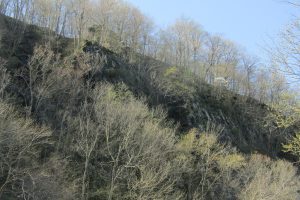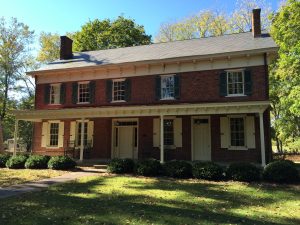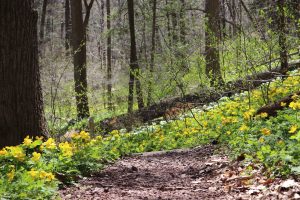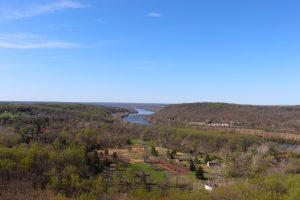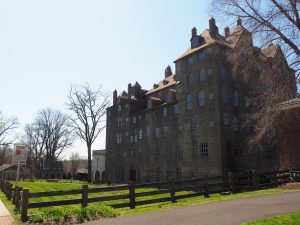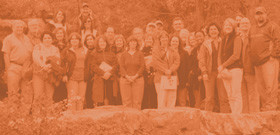The D&L Blog

July is a month of Heritage & History throughout the Corridor. We celebrated the Fourth of July at the beginning of the month (of course) and Easton Heritage Day on July 10th. There have also been special events each week as Passport to History Month continues, with 33 total museums and historic sites participating.
For this month’s Journey Through the D&L blog, we’re going to continue the trend of recognizing and celebrating heritage. Bucks is the focus of this blog – the county with the most historic sites and natural heritage areas combined in the Corridor!
Many of the sites and areas you may recognize, as they can be found along the D&L Trail! Some Historic Sites and Natural Heritage Areas are private residences; please be respectful when observing these locations.
Nockamixon Cliffs
Are you into a bit of thrill-seeking? Or maybe you just really like birds? Well, this two-mile stretch of 250-300ft cliffs offers it all.
Just off the D&L Trail, the Nockamixon Cliffs are geological structures said to have formed approximately 250 million years ago. Currently part of Nockamixon State Park, this Natural Heritage Area is home to more than 90 species of birds. Nockamixon is also considered one of the most important botanical sites in eastern Pennsylvania.
The Erwin-Stover House & Barn
Built in 1810 by William Erwin, the house originally had five rooms – a significant difference from the house that stands today. Over the years, the house would come to have an additional seven rooms added to it by the Stovers, a local miller family.
The Stover’s descendants donated the property in 1955 to become part of Tinicum Park, Bucks County’s first public park! The House is open weekends, May through October for tours and programs.*
Just a mile away is the Isaac Stover House, home to the son of Henry Stover and brother to Jacob Stover. In the 1990s this house operated as an inn. The property is now privately owned but can be viewed from the street.*
Bowman’s Hill
With 700 different species of native wildflowers (60 of which are rare) spread across the 134-acre preserve, it’s no wonder Bowman’s Hill Flower Preserve is a Natural Heritage Area.
The staff at the preserve have worked for 80 years to conserve and encourage growth of Pennsylvania’s rich natural heritage and biodiversity. This location is just off the D&L Trail at the Thompson Neely Trailhead in Washington Crossing Historic Park. You can stop by and explore the land, visit Pidcock Creek (another Natural Heritage Area), or buy some native plants. You can even start heading towards the next location!
Bowman’s Hill Tower rises 125ft off the ground to overlook 14-miles of scenic pastures and waterways.
On a clear day, you can even observe the vast distance George Washington and his men had to travel during their historic crossing of the Delaware River on December 25, 1776.
Although, despite common belief, this castle-like tower was not actually there to see the event. In fact, it wouldn’t be for another 215 years! Construction for the tower began in 1929; it was built using native stone quarried from Bowman’s Hill.
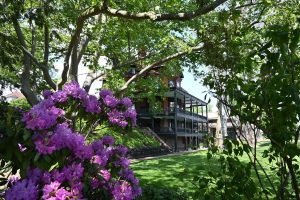
Grundy Museum
Overlooking the scenic Delaware River, is the Grundy Museum. Filled with portraits, gold-embellished furniture, eclectic sculptures, and historic documents that hint at the lives of one of Bucks County’s most prominent families. The museum is open for guided tours that offer insight into the people that once called the museum home.
The Grundy House-turned-Museum serves as a glimpse into the Victorian period just minutes away from the D&L Trail.
Bristol Marsh
Located at the head of Mouth Creek is the Bristol Marsh. According to Heritage Conservancy, it is one of the few remaining freshwater marshes located along the Delaware River and is home to at least six different rare plant species.
Right on the D&L Trail, you can observe the various migratory birds and waterfowl that call the marsh home.
Doylestown
Miles away from the D&L Trail is a location in the Corridor that is home to not one, not two, but three of the five castles located in Bucks County.
Fonthill, Mercer Museum, and Moravian Pottery and Tile Works are all properties built by Henry Chapman Mercer, local Doylestown tile maker, historian, and anthropologist. Each location functions as a museum dedicated to displaying artefacts that Mercer collected (or created) during his lifetime.
Historic Sites & Natural Heritage Areas
A Historic Site is a location where elements of historic (and prehistoric) events have been preserved due to their cultural heritage value. These sites are recognized by their local and state governments, and in some cases, even the federal government. Within Bucks County alone, there are 162 Historic Sites registered in the National Register of Historic Places.
Natural Heritage Areas are sites with “areas that support rare plants or animals, exemplary ecological communities, and Pennsylvania’s native species biodiversity,” according to the Pennsylvania Natural Heritage Program. Bucks County is home to 121 Natural Heritage Areas, just two short of Luzerne County’s 123.
(The DLNHC has a total of 329 Historic Sites and 403 Natural Heritage Areas across all five counties!)
To view a story map of the National Register of Historic Places in Bucks County, click on this link.
To view a story map of many of the Natural Heritage Areas found within Bucks County, click here. You can find a story map of the Natural Heritage Areas in your own county, by visiting this link.
Written by Gianna Caruso, DLNHC Communications Coordinator

